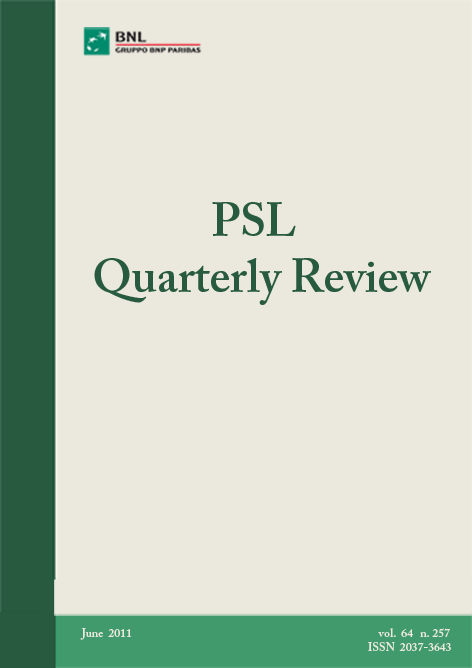Framing world monetary system reform: Fritz Machlup and the Bellagio Group conferences
DOI:
https://doi.org/10.13133/2037-3643/9416Keywords:
world monetary system, Fritz Machlup, Bellagio GroupAbstract
This paper explores the influence of Fritz Machlup and the Bellagio Group on world monetary reform. After an examination of the literature, the paper addresses research into Machlup’s framing of the problem of world monetary reform, his method, his selection of economists to join the Bellagio Group, his close working relationship with the treasury and central bank officials who were the deputies of the Group of Ten, and his creation of a broad platform of joint conferences, papers and books to promote their work. Taking an historico-biographical approach, this paper draws on the archives and published works of Fritz Machlup, Robert Triffin and their contemporaries.
JEL Codes: B22, B31, F31, F33
References
BACKHOUSE R. and MIDDLETON R. (2000), Exemplary economists: North America, Cheltenham (UK): Edward Elgar.
BORDO M. and EICHENGREEN B. (2000), “The rise and fall of a barbarous relic: the role of gold in the international monetary system”, NBER Working Paper, n. 6436, pp. 1-87.
BORDO M., TAYLOR A. and WILLIAMSON J. (2003), Globalization in historical perspective, Chicago: University of Chicago Press.
DEVRIES M. (1987), Balance of payments adjustment, Washington (DC): International Monetary Fund.
DREYER J. (ed.), (1978), Breadth and depth of economics: Fritz Machlup: the man and his ideas, Toronto: Lexington Books.
EICHENGREEN B. (2008), Globalizing capital, Princeton (NJ): Princeton University Press.
EICHENGREEN B. and JAMES H. (2003), “Monetary and financial reform in the two eras of globalization”, in Bordo M., Taylor A. and Williamson J. (eds.), pp. 515-548.
ENTMAN R. (1993), “Framing: toward clarification of a fractured paradigm” Journal of Communication, vol. 43 n. 4, pp. 51-58.
FELLNER W., MACHLUP F. and TRIFFIN R. (1966), Maintaining and restoring balance in international payments, Princeton (NJ): Princeton University Press.
INTERNATIONAL MONETARY FUND (1987), “The role of the SDR in the international monetary system”, Occasional Paper, n. 51, Washington (DC).
JAMES H. (2010), “The multiple contexts of Bretton Woods”, Past and Present, Supplement n. 6, pp. 290-308.
MACHLUP F. (1947-1983), Papers, Hoover Institution Archives, Stanford (CA).
MACHLUP F. (1958), “Equilibrium and disequilibrium: misplaced concreteness and disguised politics”, The Economic Journal, vol. 68, pp. 1-24.
MACHLUP F. (1964), International monetary arrangements: the problem of choice, International Finance Section, Princeton (NJ): Princeton University Press.
MACHLUP F. (1965), “Why economists disagree”, Proceedings of the American Philosophical Society, vol. 109, pp 1-7.
MACHLUP F. (1982), “My work on international monetary problems, 1940-1964”, Banca Nazionale del Lavoro Quarterly Review, vol. 140, pp. 3-36.
MINTZ A. and REDD S. (2003), “Framing effects in international relations”, Synthese, vol. 135 n. 1, pp. 193-213.
NELSON T., OXLEY Z. and CLAWSON R. (1997), “Toward a psychology of framing effects”, Political Behavior, vol. 19 n. 3, pp. 221-246.
SNOW D. and BENDFORD R. (1992), “Master frames and cycles of protest”, in Morris A. and Muller C. (eds.), Frontiers in social movement theory, New Haven (CT): Yale University Press, pp. 133-155.
SOLOMON R. (1977), The international monetary system, 1945-1976: An insider’s view, New York (NY): Harper & Row.
TONIOLO G. (2005), Central bank cooperation at the Bank for International Settlements, 1930-1973, New York (NY): Cambridge University Press.
TRIFFIN R. (1934-1978), Papers, Yale University, New Haven.
TRIFFIN R. (1978), “The impact of the Bellagio Group on world monetary reform”, in Dreyer J. (ed.), pp. 145-158.
TRIFFIN R. (1959), Statement in employment, growth and price levels, hearings before the Joint Economic Committee, Congress of the United States, 86th Congress, First Session, Part 9A, pp. 2905-2954.
TRIFFIN R. (1957), Europe and the money muddle: from bilateralism to near convertibility, 1947-1956, London: Oxford University Press.
WILSON J. (2004), “Le Groupe de Bellagio: origines et premiers pas (1960-1964)”, in Dumoulin, M. (ed.), Economic networks and European integration, Brussels: P.I.E. Peter Lang, pp. 391-410.
Downloads
Published
How to Cite
Issue
Section
License



